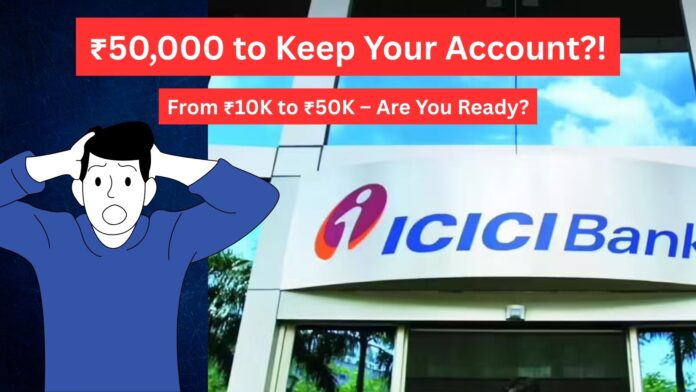ICICI Bank’s New Rules: A Strategic Shift?
By: Javid Amin | 13 Aug 2025
A Bold Banking Pivot
ICICI Bank, India’s second-largest private sector lender, has never shied away from innovation. From pioneering internet banking in the early 2000s to aggressive credit card expansion, it has often set benchmarks for the industry.
But its latest policy overhaul, effective August 1, 2025, is different. This isn’t just about technology adoption or product diversification — it’s a strategic redefinition of its customer base.
By raising the Monthly Average Balance (MAB) requirement for urban savings accounts to ₹50,000 and introducing ₹6 UPI transaction fees beyond certain thresholds, ICICI is signalling a shift toward premium banking — a move that’s sparking intense debate across the financial and social landscape.
The New Rules – What Exactly Has Changed?
01. Monthly Average Balance Hike
Under the new norms:
-
Metro & Urban branches: ₹50,000 MAB (previously ₹10,000)
-
Semi-urban branches: ₹25,000 MAB (previously ₹5,000–₹10,000)
-
Rural branches: ₹10,000 MAB (unchanged)
Penalty: If your MAB falls short, the bank will charge 6% of the shortfall amount or ₹500, whichever is lower.
Example:
If you maintain ₹25,000 instead of ₹50,000 in an urban account:
Shortfall = ₹25,000 → 6% = ₹1,500 → Penalty = ₹500 (since it’s capped at ₹500).
02. UPI Transaction Fee
ICICI has introduced a ₹6 charge per UPI transaction beyond a certain free transaction limit (varies by account type).
While smaller retail users may not hit this threshold easily, heavy UPI users — such as small business owners, freelancers, or high-frequency bill payers — could see these charges add up quickly.
Why Is ICICI Doing This?
This move is not random — it fits into three broader strategic goals.
01. Premiumization Strategy
ICICI is increasingly focusing on mass-affluent and high-net-worth (HNI) customers. This segment is more likely to:
-
Maintain large balances
-
Buy mutual funds, insurance, and structured investment products
-
Take personal and home loans with larger ticket sizes
By raising the entry threshold, ICICI is weeding out low-balance accounts that yield little profit but consume operational resources.
02. Cost Recovery in a Low-Interest Era
With savings account interest rates at 2.75%, banks earn less from deposits than before. Meanwhile:
-
UPI transactions cost banks money due to backend infrastructure and security investments.
-
“Free” banking services have operational expenses.
By monetizing UPI beyond a limit and charging for low balances, ICICI can offset these costs.
03. Digital Push and Bundled Premium Accounts
ICICI has been rolling out bundled products such as Wealth Management Accounts, Private Banking, and Smart Privilege Accounts.
Higher MAB norms and small UPI fees act as a nudge for customers to upgrade to these premium categories, where many services are “free” but require higher deposits or investment commitments.
Risks & Potential Backlash
While financially logical, the strategy has clear risks.
01. Accessibility Concerns
India’s middle class and lower-income urban workers may find ₹50,000 MAB unrealistic. This could push them toward:
-
Public sector banks (PSBs) like SBI, which have zero minimum balance
-
Private competitors like HDFC or Axis, which have ₹2,500–₹10,000 MAB
02. Brand Perception Shift
ICICI risks being seen as an elitist bank that prioritizes wealthier customers over inclusivity. This could:
-
Reduce customer goodwill
-
Hurt long-term retail deposit growth
-
Trigger negative press and social media campaigns
03. Account Closures & Migration
Analysts expect a possible 5–10% attrition in low-value accounts within the next year if customers migrate to zero-MAB banks.
How ICICI Compares to Rivals
| Bank | MAB (Metro/Urban) | UPI Charges | Approach |
|---|---|---|---|
| ICICI Bank | ₹50,000 | ₹6 beyond free limit | Premiumization |
| HDFC Bank | ₹10,000 | Mostly free | Mass retail focus |
| Axis Bank | ₹10,000 | Mostly free | Hybrid |
| SBI | Zero | Free | Mass-market inclusion |
| Kotak 811 | Zero (digital) | Free | Digital-first inclusion |
ICICI’s stance is now the most premium-oriented among large banks in India.
Public Reaction – Voices from the Ground
Anjali Mehta, Freelance Designer:
“I chose ICICI for convenience, not because I’m wealthy. ₹50,000 sitting idle in my account is money I can’t invest or use. I’ll move to SBI if needed.”
Ramesh Wani, Small Retailer:
“I make 20–25 UPI payments a day for supplies. These charges will eat into my margins.”
Social media hashtags like #ICICIBankCharges and #BankForTheRich are already trending, with customers posting screenshots of account closure requests.
Will the Strategy Work? – Two Possible Futures
01. Success Scenario
-
Low-value accounts migrate, operational costs drop.
-
ICICI deepens ties with affluent customers, boosting wealth management revenue.
-
Premium branding attracts HNI clients from competitors.
02. Backfire Scenario
-
Negative publicity triggers larger-than-expected customer migration.
-
Loss of mass retail base weakens CASA (Current Account Savings Account) ratios.
-
Rivals capture market share, especially in digital banking.
The Bigger Banking Trend – Not Just ICICI
Globally, banks are moving toward fee-based income and tiered service models.
-
In the US, banks charge for excessive transactions or low balances.
-
In the UK, “free” current accounts are increasingly bundled with premium services.
In India, this shift is slower due to financial inclusion mandates, but private banks are pushing toward profitability over pure customer volume.
The Way Forward – Balancing Profit and Inclusion
For ICICI, the challenge is navigating the fine line between profitability and alienation. Possible steps:
-
Offering zero-balance digital-only accounts for younger customers.
-
Providing UPI fee exemptions for essential transactions like utilities or education.
-
Running financial literacy campaigns to justify the value of premium services.
Conclusion – A Defining Moment for ICICI Bank
ICICI Bank’s ₹50,000 MAB and ₹6 UPI fee policy is not just a rule change — it’s a declaration of intent. The bank wants fewer customers, higher revenue per customer, and a premium image.
Whether this strategy secures long-term growth or sparks a loyalty crisis depends on how many customers see value in paying for exclusivity — and how many simply walk away.



